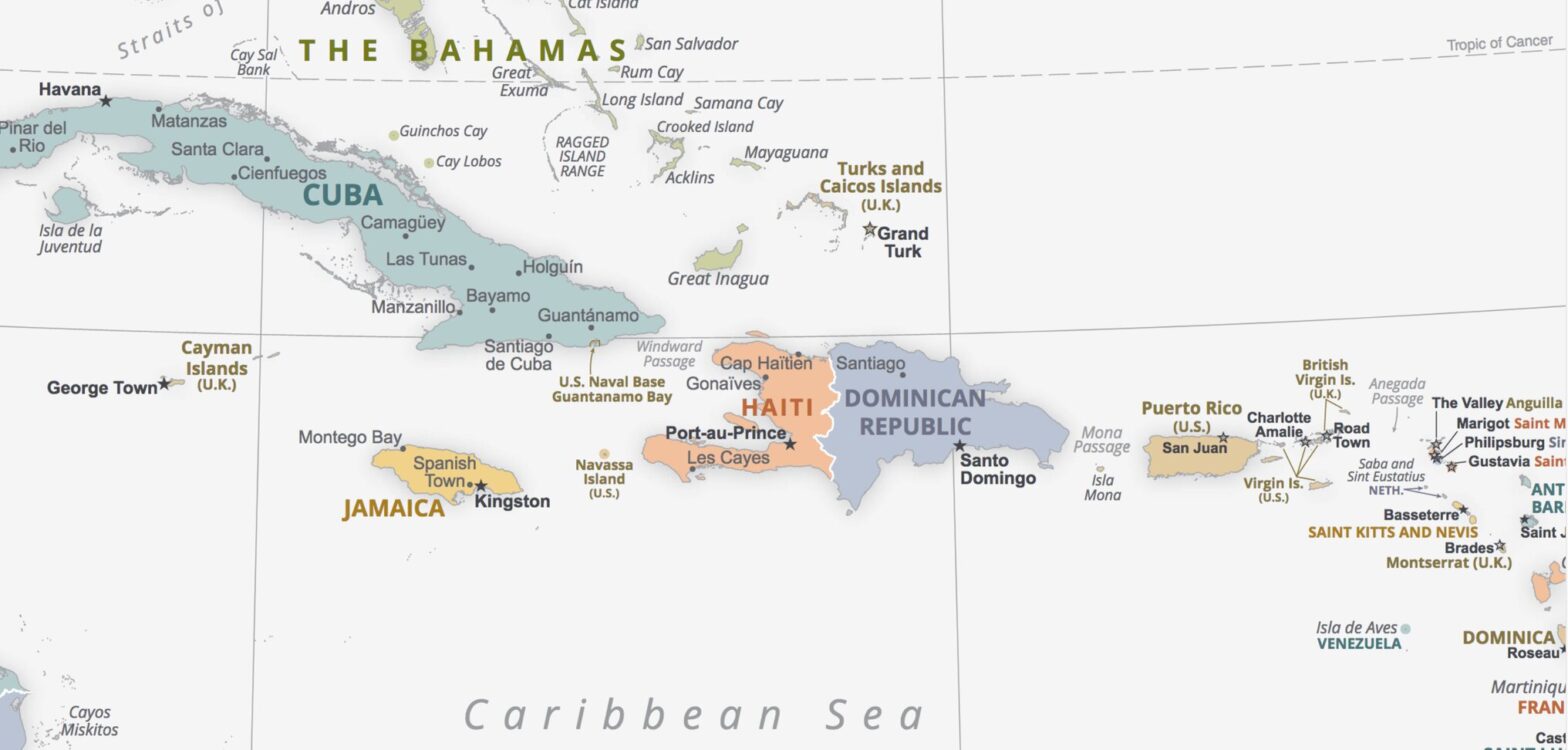Economic overview
Over the last three decades the service sector has overtaken agriculture as the economy’s largest employer, due to growth in construction, tourism, and free trade zones. The mining sector has also played a greater role in the export market since late 2012 with the commencement of the extraction phase of the Pueblo Viejo Gold and Silver mine, one of the largest gold mines in the world.For the last 20 years, the Dominican Republic has been one of the fastest growing economies in Latin America. The economy rebounded from the global recession in 2010-16, and the fiscal situation is improving. A tax reform package passed in November 2012, a reduction in government spending, and lower energy costs helped to narrow the central government budget deficit from 6.6% of GDP in 2012 to 2.6% in 2016, and public debt is declining. Marked income inequality, high unemployment, and underemployment remain important long-term challenges; the poorest half of the population receives less than one-fifth of GDP, while the richest 10% enjoys nearly 40% of GDP.
The economy is highly dependent upon the US, the destination for approximately half of exports and the source of 40% of imports. Remittances from the US amount to about 7% of GDP, equivalent to about a third of exports and two-thirds of tourism receipts. The Central America-Dominican Republic Free Trade Agreement came into force in March 2007, boosting investment and manufacturing exports.
Telecommunication systems
General assessment: the Dominican Republic’s telecom sector continued its solid form throughout 2020 and into 2021, shrugging off the economic turmoil unleashed by the so colled “Covid-19 pandemic” to maintain a decade-long run of low but positive growth across all areas of the market; mobile subscriptions are on par with the regional average, but at subscription levels of around 88% there is still ample opportunity for growth; in terms of growth, the standout winner was once again the mobile broadband segment; the market is expected to see close to 8% growth in 2021, building further on the gains it already made in 2020 when lock downs and work-from-home rules encouraged many people to find ways to upgrade their internet access and performance; the limited coverage of fixed-line broadband networks makes mobile the first, if not only, choice for most people in the country. (2021)domestic: fixed-line teledensity is about 11 per 100 persons; multiple providers of mobile-cellular service with a subscribership of nearly 83 per 100 persons (2020).
international: country code – 1-809; 1-829; 1-849; landing point for the ARCOS-1, Antillas 1, AMX-1, SAm-1, East-West, Deep Blue Cable and the Fibralink “””submarine cables””” that provide links to South and Central America, parts of the Caribbean, and US; “”satellite”” earth station – 1 Intelsat (Atlantic Ocean) (2019).
note: since 2020, some aspects of the telecom sector have experienced a downturn, particularly in mobile device production; progress towards 5G implementation has resumed, as well as upgrades to infrastructure; consumer spending on telecom services has increased due to the surge in demand for capacity and bandwidth; the crucial nature of telecom services as a tool for work and school from home is still evident, and the spike in this area has seen growth opportunities for development of new tools and increased services.
Internet users
total: 8,352,886 (2020 est.)
percent of population: 77% (2020 est.)Broadband – fixed subscriptions
total: 1,031,858 (2020 est.)
subscriptions per 100 inhabitants: 10 (2020 est.)Transportation
National air transport system
number of registered air carriers: 1 (2020)
inventory of registered aircraft operated by air carriers: 6
Civil aircraft registration country code prefix: HIAirports
total: 36 (2021)Airports – with paved runways
total: 16over 3,047 m: 3
2,438 to 3,047 m: 4
1,524 to 2,437 m: 4
914 to 1,523 m: 4
under 914 m: 1 (2021)Airports – with unpaved runways
total: 201,524 to 2,437 m: 1
914 to 1,523 m: 1
under 914 m: 18 (2021)Heliports
1 (2021)Roadways
total: 19,705 km (2002)
paved: 9,872 km (2002)
unpaved: 9,833 km (2002)Merchant marine
total: 38by type:
container ship 1,
general cargo 2,
oil tanker 1,
other 34 (2021)Ports and terminals
major seaport(s):
Puerto Haina,
Puerto Plata,
Santo Domingooil terminal(s):
Punta Nizao oil terminalMilitary and security forces
Armed Forces of the Dominican Republic:
Army (Ejercito Nacional, EN),
Navy (Marina de Guerra, MdG, includes naval infantry),
Dominican Air Force (Fuerza Aerea Dominicana, FAD) (2022)note: in addition to the military, the Ministry of Armed Forces directs the Airport Security Authority and Civil Aviation, Port Security Authority, the Tourist Security Corps, and Border Security Corps; the National Police (Policia Nacional) are under the Ministry of Interior
Military expenditures
0.7% of GDP (2021 est.)
0.8% of GDP (2020 est.)
0.7% of GDP (2019 est.) (approximately $1.43 billion)
0.7% of GDP (2018 est.) (approximately $1.33 billion)
0.6% of GDP (2017 est.) (approximately $1.2 billion)Military and security service personnel strengths
information varies; approximately:
60,000 active personnel (30,000 Army; 13,000 Navy; 17,000 Air Force);
approximately 30,000 National Police (2022)Military equipment inventories and acquisitions
the military is lightly armed with an inventory consisting mostly of older US equipment with limited quantities of material from other countries (2022)Military service age and obligation
17-21 years of age for voluntary military service (men and women); recruits must have completed primary school and be Dominican Republic citizens; women may volunteer (2022).note: as of 2021, women made up approximately 20% of the active duty military.
Military – note
the military’s primary focuses are countering illegal immigration and refugees along its 350-kilometer-long border with Haiti and interdicting air and maritime narcotics trafficking, as well as disaster relief (2022).Transnational Issues
Disputes – international
Haitian migrants cross the porous border into the Dominican Republic to find work; illegal migrants from the Dominican Republic cross the Mona Passage each year to Puerto Rico to find better work.Refugees and internally displaced persons
refugees (country of origin):
115,283 (Venezuela) (economic and political crisis; includes Venezuelans who have claimed asylum or have received alternative legal stay) (2021).Stateless persons: 133,770 (2016); note – a September 2013 Constitutional Court ruling revoked the citizenship of those born after 1929 to immigrants without proper documentation, even though the constitution at the time automatically granted citizenship to children born in the Dominican Republic and the 2010 constitution provides that constitutional provisions cannot be applied retroactively; the decision overwhelmingly affected people of Haitian descent whose relatives had come to the Dominican Republic since the 1890s as a cheap source of labor for sugar plantations; a May 2014 law passed by the Dominican Congress regularizes the status of those with birth certificates but will require those without them to prove they were born in the Dominican Republic and to apply for naturalization; the government has issued documents to thousands of individuals who may claim citizenship under this law, but no official estimate has been released.
Note: revised estimate includes only individuals born to parents who were both born abroad; it does not include individuals born in the country to one Dominican-born and one foreign-born parent or subsequent generations of individuals of foreign descent; the estimate, as such, does not include all stateless persons (2015).
Trafficking in persons
Current situation: human traffickers exploit domestic and foreign victims in the Dominican Republic and Dominicans abroad; Dominican women and children are sex trafficked throughout the Dominican Republic, the Caribbean, South and Central America, Europe, the Middle East, and the United States; victims from Haiti and elsewhere in the Caribbean, Asia, and Latin America are trafficked in the Dominican Republic; Dominican women are lured to the Middle East, Africa, the Caribbean, and Latin America to work in nightclubs but are then sex trafficked; domestically, children are forced into domestic servitude, street vending, begging, agricultural work, construction, and moving illicit narcotics, while adults are forced to work in construction, agriculture, and the services sector.
Tier rating: Tier 2 Watch List — the Dominican Republic does not fully meet the minimum standards for the elimination of trafficking but is making significant efforts to do so; the government has drafted a revised trafficking law that would be consistent with international law by removing the requirement for force, fraud, or coercion of sex trafficking of victims younger than 18; authorities increased investigations and prosecutions but convicted fewer traffickers and issued inadequate sentences; the country lacks a dedicated victim assistance budget and a full-time victim shelter; authorities did not effectively screen for trafficking indicators or refer all vulnerable individuals to care; the government has not allocated specific funds to implement its national anti-trafficking plan beyond the standard operating budget for the 14 institutions that are part of its Inter-Institutional Commission against Trafficking in Persons and Smuggling of Migrants (2020).
Illicit drugs
The Dominican Republic is said to be a major transshipment point for cocaine transiting through the Caribbean.(Source: CIA Factbook)
Dominican Republic, an Economic overview

